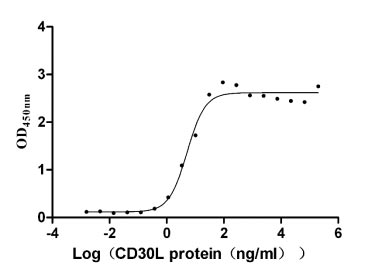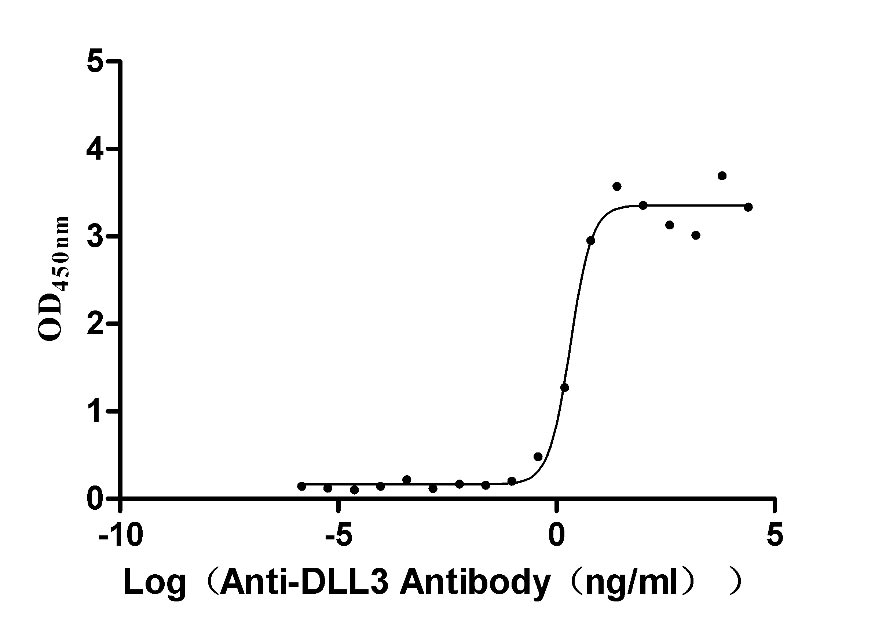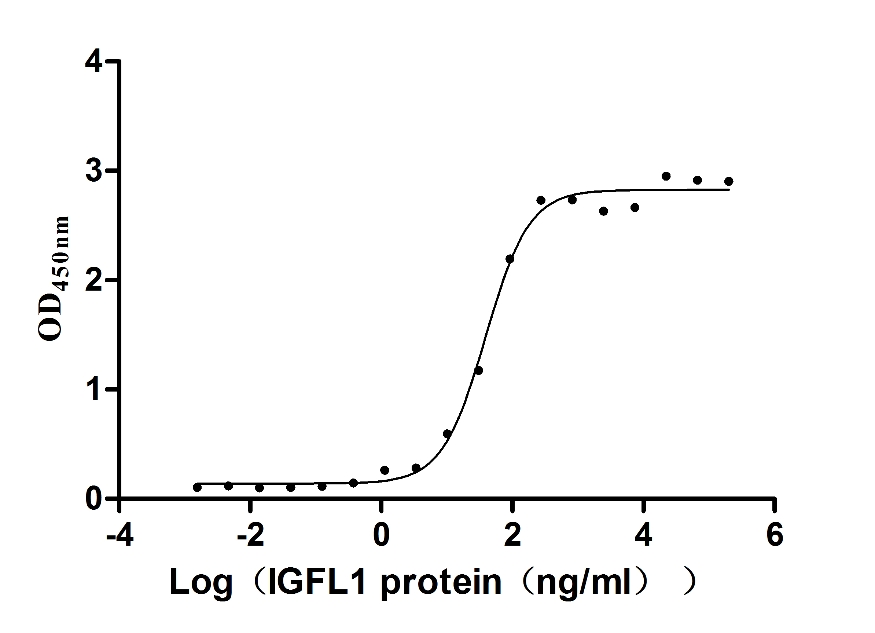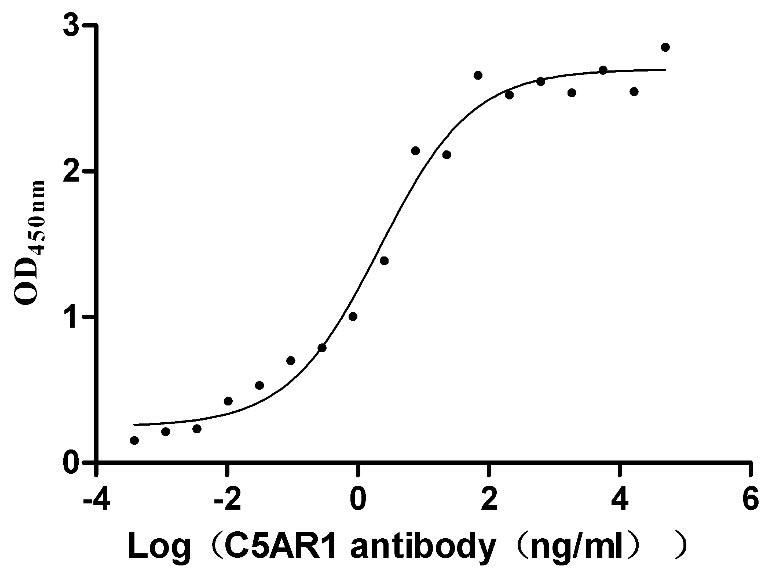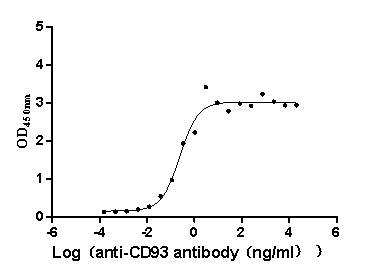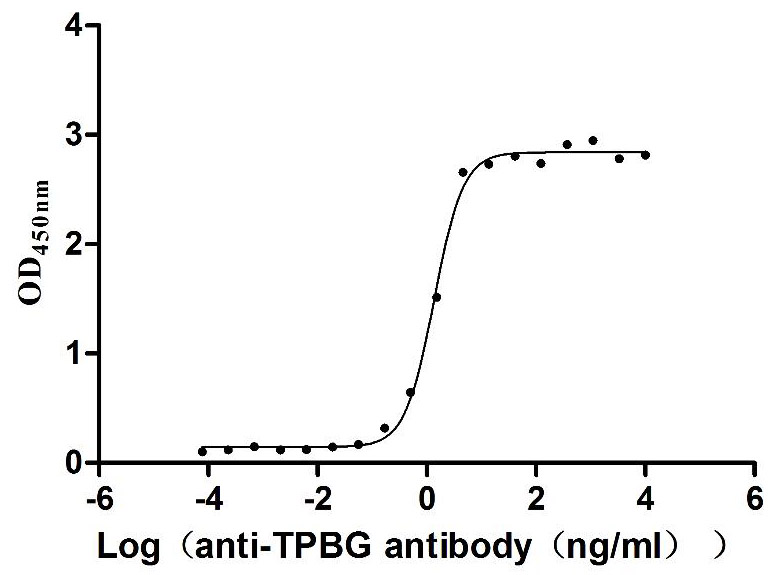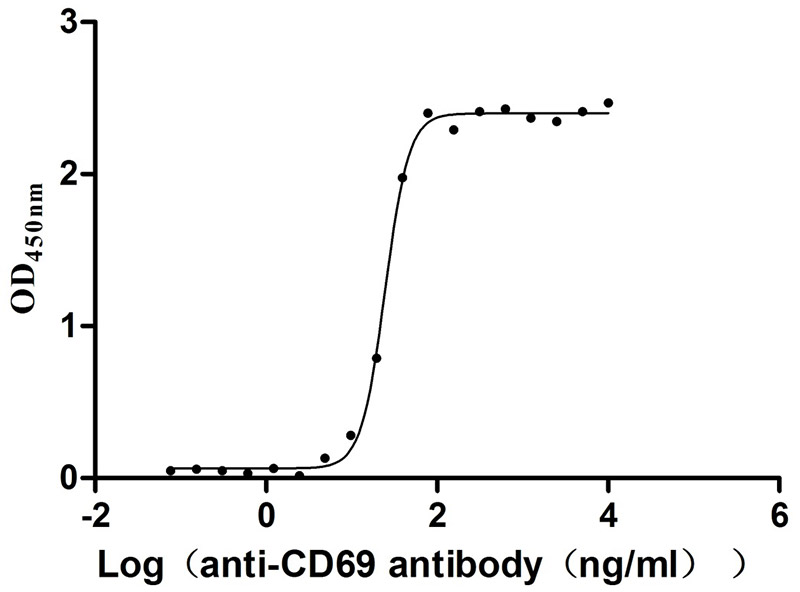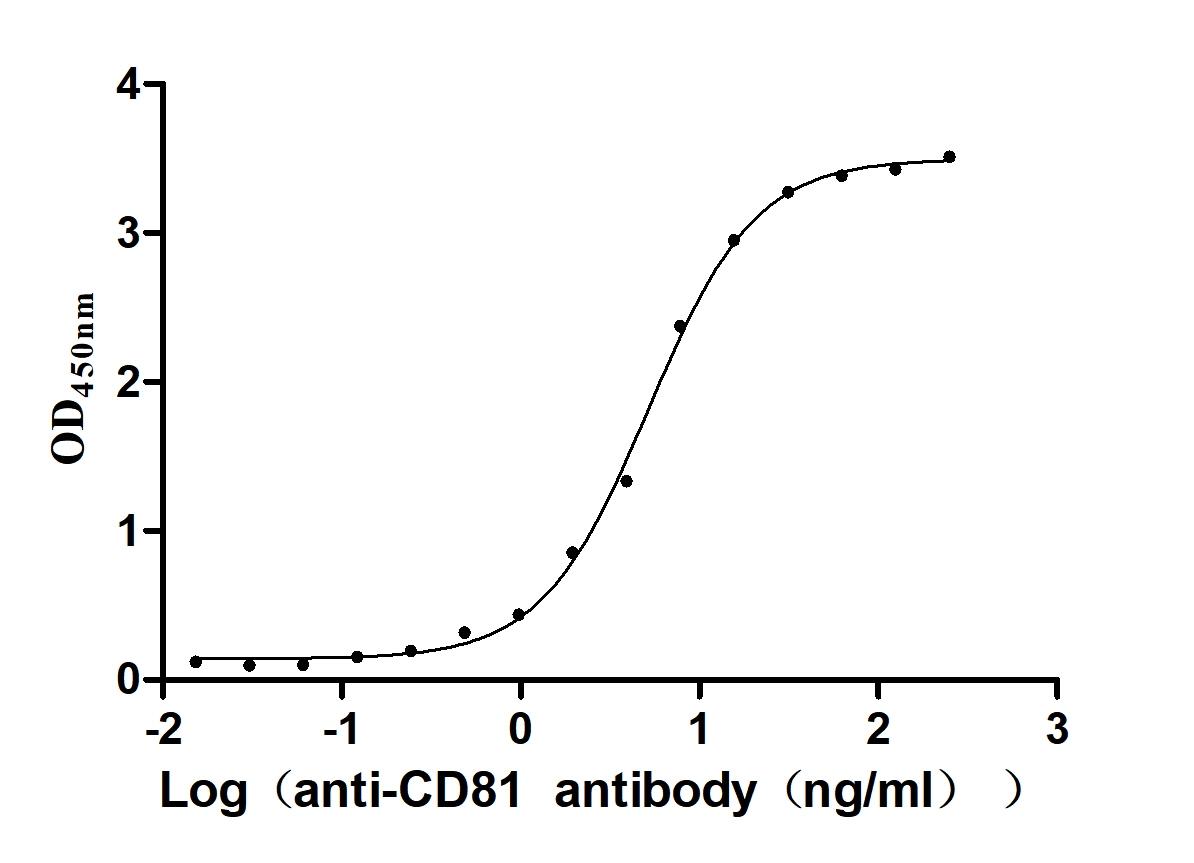Recombinant Mouse Melanopsin (Opn4), partial
-
中文名稱:小鼠Opn4重組蛋白
-
貨號:CSB-YP879449MO1
-
規格:
-
來源:Yeast
-
其他:
-
中文名稱:小鼠Opn4重組蛋白
-
貨號:CSB-EP879449MO1
-
規格:
-
來源:E.coli
-
其他:
-
中文名稱:小鼠Opn4重組蛋白
-
貨號:CSB-EP879449MO1-B
-
規格:
-
來源:E.coli
-
共軛:Avi-tag Biotinylated
E. coli biotin ligase (BirA) is highly specific in covalently attaching biotin to the 15 amino acid AviTag peptide. This recombinant protein was biotinylated in vivo by AviTag-BirA technology, which method is BriA catalyzes amide linkage between the biotin and the specific lysine of the AviTag.
-
其他:
-
中文名稱:小鼠Opn4重組蛋白
-
貨號:CSB-BP879449MO1
-
規格:
-
來源:Baculovirus
-
其他:
-
中文名稱:小鼠Opn4重組蛋白
-
貨號:CSB-MP879449MO1
-
規格:
-
來源:Mammalian cell
-
其他:
產品詳情
-
純度:>85% (SDS-PAGE)
-
基因名:
-
Uniprot No.:
-
別名:Opn4; Mop; Mopn; Melanopsin; Opsin-4
-
種屬:Mus musculus (Mouse)
-
蛋白長度:Partial
-
蛋白標簽:Tag?type?will?be?determined?during?the?manufacturing?process.
The tag type will be determined during production process. If you have specified tag type, please tell us and we will develop the specified tag preferentially. -
產品提供形式:Lyophilized powder
Note: We will preferentially ship the format that we have in stock, however, if you have any special requirement for the format, please remark your requirement when placing the order, we will prepare according to your demand. -
復溶:We recommend that this vial be briefly centrifuged prior to opening to bring the contents to the bottom. Please reconstitute protein in deionized sterile water to a concentration of 0.1-1.0 mg/mL.We recommend to add 5-50% of glycerol (final concentration) and aliquot for long-term storage at -20℃/-80℃. Our default final concentration of glycerol is 50%. Customers could use it as reference.
-
儲存條件:Store at -20°C/-80°C upon receipt, aliquoting is necessary for mutiple use. Avoid repeated freeze-thaw cycles.
-
保質期:The shelf life is related to many factors, storage state, buffer ingredients, storage temperature and the stability of the protein itself.
Generally, the shelf life of liquid form is 6 months at -20°C/-80°C. The shelf life of lyophilized form is 12 months at -20°C/-80°C. -
貨期:Delivery time may differ from different purchasing way or location, please kindly consult your local distributors for specific delivery time.Note: All of our proteins are default shipped with normal blue ice packs, if you request to ship with dry ice, please communicate with us in advance and extra fees will be charged.
-
注意事項:Repeated freezing and thawing is not recommended. Store working aliquots at 4°C for up to one week.
-
Datasheet :Please contact us to get it.
相關產品
靶點詳情
-
功能:Photoreceptor that binds cis-retinaldehydes. Contributes to pupillar reflex, photoentrainment and other non-image forming responses to light. May be involved in the optokinetic visual tracking response. May be involved in the regulation of retinal hyaloid vessel growth and regression.
-
基因功能參考文獻:
- we show that OPN2 and OPN4 participate in immediate pigment darkening induced by UVA in murine normal and malignant melanocytes through a conserved common pathway PMID: 29395480
- Data from mouse model reveal a distinct melanopsin contribution to encoding visual images, predicting that, under natural view, melanopsin augments the early visual system's ability to encode patterns over moderate spatial scales. PMID: 28528909
- A subset of M1 and M1d melanopsin ganglion cells are biplexiform with dendrites ramifying both in the inner plexiform layer and either in the inner plexiform layer or the outer plexiform layer. We have found five types of Outer Retinal Dendritess in the OPL categorized by their morphology and the melanopsin ganglion cell subtype from which they originate. PMID: 28758193
- our results highlight how the kinetics of the melanopsin photoresponse differentially regulate distinct light-mediated behaviors. PMID: 28223508
- Melanopsin contributes to irradiance modulation of narrowband oscillations in the retina and dorsal lateral geniculate nucleus. PMID: 28103478
- discovery that amino acid sequence features of melanopsin protein contribute to the functional properties of the intrinsically photosensitive retinal ganglion cells PMID: 27181062
- When compared with wildtype responses, sleep onset in melanopsin (OPN4-/-) mice was significantly advanced under blue light, whereas under violet and green light it was significantly delayed. PMID: 27276063
- Melanopsin overexpression in RGCs enhanced the amplitude and duration of their light response, and silencing them with Kir2.1 significantly suppressed the increased mTOR signaling and axon regeneration that were induced by melanopsin PMID: 26831088
- mice null for melanopsin (Opn4-/-), lost significantly more weight than wild-type controls or mice lacking rod and cone photoreceptors. PMID: 26011287
- These results suggest GRK2 contributes to melanopsin deactivation, but that other mechanisms account for most of modulation of melanopsin activity in ipRGCs. PMID: 26069965
- Using a combination of conventional knockout, chemogenetic, and receptor-silent substitution manipulations, we continued to show that, over higher irradiances, this increase in firing originates with inner-retinal melanopsin photoreception PMID: 26438865
- Opn4 mediates wavelength-specific, light-dependent vascular relaxation. PMID: 25404319
- Data indicate that retinal molecular circadian clock can be entrained by lighting cycles in vitro, but that rods, cones, and melanopsin (Opn4) are not required for this entrainment. PMID: 24843129
- critical phosphorylation sites on the carboxy tail of melanopsin PMID: 24678795
- Melanopsin Is required for normal Sensitivity and expression in alpha retinal ganglion cells. PMID: 24853938
- the role of melanopsin-expressing retinal ganglion cells in the glaucoma-induced depressive behavioral response pattern was investigated PMID: 23729182
- melanopsin is important for initiation and maintenance of light-induced sleep during the dark phase. PMID: 23510299
- The attenuation of the melanopsin-based light response by dopamine is mediated by direct PKA phosphorylation of melanopsin. PMID: 23049792
- when mice are mutated in the gene (Opn4) for the atypical opsin melanopsin, or are dark-reared from late gestation, the hyaloid vessels are persistent at 8 days post-partum and the retinal vasculature overgrows PMID: 23334418
- The sustained-type light response of retinal dopamine neurons requires melanopsin. PMID: 22880066
- UV light exposure induces sleep in wild-type and melanopsin-deficient (Opn4(-/-)) mice with equal efficacy. PMID: 22771039
- molecular properties of melanopsin PMID: 22670683
- a model in which retinal is continuously covalently bound to melanopsin and may function through a reversible, bistable mechanism PMID: 22547062
- Opn4S mRNA was detected at relatively constant levels throughout postnatal development, with levels of Opn4S protein showing a marked increase between P0 and P3. Levels of Opn4L mRNA and protein were low at birth and markedlyd increased at P14 and P3. PMID: 22496826
- Melanopsin increase might have been induced by either a maternal or a developmental signal and is likely related to the first connections between the retina and the suprachiasmatic nucleus. PMID: 21925644
- heterologously expressed melanopsin is phosphorylated in a light-dependent manner, and this phosphorylation is involved in regulating the rate of G-protein activation and the lifetime of melanopsin's active state PMID: 22159583
- In mouse, this intrinsic pupillary light reflex requires the visual pigment melanopsin; it also requires PLCbeta4, a vertebrate homologue of the Drosophila NorpA phospholipase C which mediates rhabdomeric phototransduction. PMID: 22051675
- Light prolongs spiking during the waves and enhances the segregation of retinogeniculate afferents, and that it did so by activating melanopsin-expressing, intrinsically photosensitive retinal ganglion cells. PMID: 21642974
- Approximately 2% of retinal ganglion cells are intrinsically photosensitive express melanopsin and are necessary for light to modulate specific physiological processes in mice PMID: 21418557
- Data show that visual responses in TKO mice extend beyond the retina to encompass the lateral margins of the lateral geniculate nucleus and components of the visual cortex. PMID: 21124780
- Findings have significant implications for the understanding of how melanopsin signalling may modulate aversive responses to light. PMID: 21124784
- The study data establish melanopsin-based photoreception as a significant source of sensory input to the thalamo-cortical visual system, providing unique irradiance information and allowing visual responses to be retained even in absence of rods+cones. PMID: 21151887
- These results strongly suggest that light activation of melanopsin in intrinsically photosensitive retinal ganglion cells may regulate physiological functions such as sleep/wake cycles in preterm and neonatal infants. PMID: 20855606
- First time evidence is presented which demonstrates intraretinal ion regulation by melanopsin in vivo. PMID: 20808732
- Periods of darkness or, more likely, the sequence of light and dark periods occurring under the daily cycles might be necessary for the normal development of the melanopsin system PMID: 20435589
- the results of this study indicated that melanopsin-based phototransduction supports pattern vision in the absence of functioning rod and cone photoreceptors. PMID: 20624591
- the retina maintains a rather constant number of melanopsin-expressing retinal ganglion cells from the first postnatal day PMID: 19924643
- melanopsin containing retinal ganglion cell axons project to the suprachiasmatic nucleus and other brain nuclei involved in circadian photoentrainment or the pupillary light reflex PMID: 11834834
- melanopsin is not essential for the circadian clock to receive photic input, but it contributes significantly to the magnitude of photic responses PMID: 12481140
- critical role in circadian photoentrainment PMID: 12481141
- the diminished pupillary light reflex at high irradiances in melanopsin-knockout mice suggests that the melanopsin-associated system and the classical rod/cone system are complementary in function PMID: 12522249
- First positive correlation between the persistence of melanopsin-expressing cells and the maintenance of both circadian and pupillary responses to light in the absence of rods and cones. PMID: 12752778
- required for nonvisual photoreception in blind mice PMID: 12829787
- Melanopsin forms a photopigment capable of activating a G-protein, but its spectral properties are not consistent with the action spectrum for circadian entrainment. PMID: 14596587
- Results suggest that melanopsin in retinal ganglion cells is involved in masking, as it is in pupil contraction and phase shifts. PMID: 14680139
- Melanopsin expression is not confined to these photosensitive retinal ganglion cells, but is also expressed in the retinal pigment epithelium, a tissue with no known photosensensory role. PMID: 15046875
- melanopsin is a functional sensory photopigment, it is the photopigment of ganglion-cell photoreceptors, and these photoreceptors may use an invertebrate-like phototransduction cascade PMID: 15674243
- expression in Xenopus oocytes results in light-dependent activation of membrane currents through the Galpha(q)/Galpha(11)G protein pathway, with an action spectrum closely matching melanopsin-expressing intrinsically photosensitive retinal ganglion cells PMID: 15681390
- photosensitive retinal ganglion cells are light responsive from birth and that this photosensitivity requires melanopsin expression. PMID: 15964274
- Melanopsin is the photopigment in intrinsically photosensitive retinal ganglion cells. PMID: 16014418
顯示更多
收起更多
-
亞細胞定位:Cell membrane; Multi-pass membrane protein. Cell projection, axon. Cell projection, dendrite. Perikaryon.
-
蛋白家族:G-protein coupled receptor 1 family, Opsin subfamily
-
組織特異性:Expressed in the retinal pigment epithelium and ganglion cell layer (at protein level). Also expressed in amacrine cell layers of the retina. Weakly expressed in vibrissae, and tail.; [Isoform 1]: Observed with processes in the outer strata of inner plexi
-
數據庫鏈接:
Most popular with customers
-
Recombinant Human Tumor necrosis factor ligand superfamily member 8 (TNFSF8), partial (Active)
Express system: Mammalian cell
Species: Homo sapiens (Human)
-
Recombinant Macaca fascicularis Delta-like protein 3 (DLL3), partial (Active)
Express system: Mammalian cell
Species: Macaca fascicularis (Crab-eating macaque) (Cynomolgus monkey)
-
Recombinant Human Insulin growth factor-like family member 1 (IGFL1) (Active)
Express system: Mammalian cell
Species: Homo sapiens (Human)
-
Recombinant Human C5a anaphylatoxin chemotactic receptor 1 (C5AR1)-VLPs (Active)
Express system: Mammalian cell
Species: Homo sapiens (Human)
-
Recombinant Macaca fascicularis CD93 molecule (CD93), partial (Active)
Express system: Mammalian cell
Species: Macaca fascicularis (Crab-eating macaque) (Cynomolgus monkey)
-
Recombinant Human Trophoblast glycoprotein (TPBG), partial (Active)
Express system: Mammalian cell
Species: Homo sapiens (Human)
-
Recombinant Human Early activation antigen CD69 (CD69), partial (Active)
Express system: Mammalian cell
Species: Homo sapiens (Human)
-
Recombinant Human CD81 antigen (CD81), partial (Active)
Express system: Mammalian cell
Species: Homo sapiens (Human)


